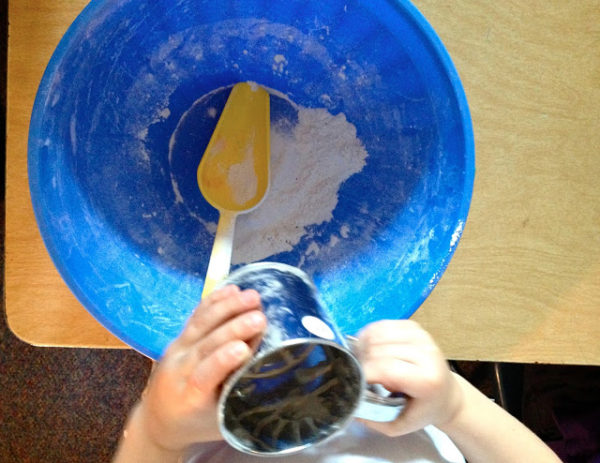Today I am bringing a series of photos of Patty Eaton's classroom – an amazing early childhood educator/expert in my area. It is a blend of Montessori, Reggio Emilia and Constructivism. It is wonderful!
Patty has agreed to co-teach an eWorkshop with me online – – -and it will happen next month! Woot! Stay tuned for the wonderful details! It will be all about creating dynamic classroom environments.
Here are a few of the trays in Patty's Practical Life center. I love the mix of basket, tin and silver trays for the work.
These trays provide the following benefits for children:
- it develops concentration
- it develops fine motor skills (to ready children for handwriting)
- it builds eye/hand coordination
- it builds dexterity
- develops control of movement
- and more.
Wide tongs to pick up small wooden blocks from one basket to another.
A wooden box of flour to spoon into the bowl.
A bowl of rice to scoop with a little ladle into a silver bowl.
Two containers with cotton balls to pick up with the tongs.
Two baskets of nuts and bolts.
Colored water mixing tray.
Turkey baster to squeeze colored water from one container to another.
Tomorrow I will share Patty and Jenni's amazing art center. So rich!!!














Sally ~ Both of my {personal} kids go to Montessori, although I, myself, am not a Montessori teach and don’t always understand everything they are doing in class. You are helping me understand more and more, and I just wanted to say, “Thank You.”
~Nikki T
Smart Tarts Learning
Yay! Montessori is so rich and there are so many layers and gifts. It makes me so happy this is helpful!
You are so right! My daughter was fortunate enough {through lottery} to get into a k-8 Montessori {public school, but funded by grants and they are hoping to get funded through H.S.!}, and is really thriving. She and my son {he started at 17 mos} went to Montessori pre-school, and I have really been pleased. THANKS again!
I have always been intrigued by Montessori and Reggio Emilia style teaching. I used to be a teacher, but I just don’t think I could ever do it in a mainstream public school again! These methods resonate so much with me; thank you for sharing! Now that I have my own kids I am getting all excited about these possibilities! Maybe when the kids are old enough for school I will think about training in one of these disciplines. What do you recommend for that? Also, off topic, I love your little Pinterest icon in your pictures!
I think getting trained in one of these would be amazing. Doing an intensive training provides such a complete and wholistic experience of alternative educational methods. There is no way I could do what I do without that background. Do it!!
This is such a neat blog! I love all the great ideas!
Awwww! Thank you! So glad you are here!
I am very happy I found your blog on UBC. You have a great site here and I will be sharing it with my teacher friends.
Thank you Susie! I loved the challenge of UBC. What a great way to jump start my blogging practice for 2013.
Hi Sally
What’s constructivism ? I know it as an art term but how does it apply to education ?
Always a treat to see what you’ve got on your mind !!
Elizabeth
Constructivism is basically the stand that the learner drives the curriculum through meaningful engaging inquiries. It holds that the learner is the maker of meaning and knowledge. Teacher is facilitator. That is a broad description.
What a great site! I will be back again! Colorful and creative…two of my favorite things!
Yay! So glad you dropped by my corner of the internet!
Thank you so much for sharing all of this! It’s very inspiring 🙂
One of my favorite things is to visit other classrooms. A good classroom can inspire me for weeks!
I notice that Montessori uses trays and I am curious why they use trays?
Hi,
Montessori teacher chiming in here. Trays are used in Montessori classrooms for children of all ages from toddler through elementary.
They help to organize the available work on shelves, creating the opportunity for children to independently choose and return their work.
Trays also assist in making a work “self-contained” – the child can take the tray and find all the materials needed to complete the objective of that work.
Finally, carrying trays builds gross motor development in young children and – regardless of the child’s age – reinforces the concept of taking care of their work (balancing the items on the tray, not tipping the tray so that materials fall and/or break, setting the tray down carefully, walking around any obstacles they may encounter in the room) and being respectful of the classroom materials.
I’ve been a family child care provider for 37 years. Montessori-type ‘work’ activities have been a part of my program for years. Like the rice-spooning activity, we spoon lentils and beans. It’s pretty amazing to watch the kids do this. I also have a basket of cloth napkins that we call our “folding cloths.” At first I teach about folding them into squares, triangles, rectangles, but the children use them for everything from doll blankets to making secret places for the action figures. I’ve gotten rid of plastic and use baskets and wooden things. After your blog a few years ago showing markers and colored pencils displayed separately, I found matching glasses at a thrift shop and put paint strips from a home improvement store in front of each color. They look so nice and my group of 2-5 year olds have not broken one! Thanks for sharing your brilliance!